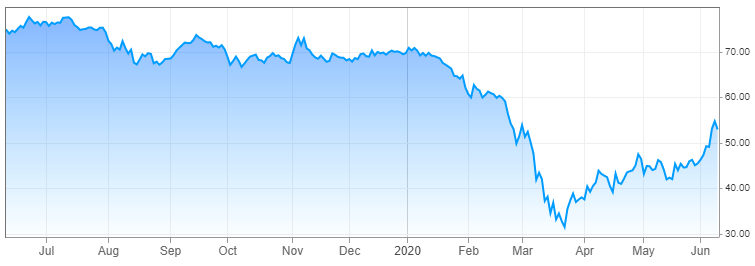Exxon Mobil Stock Falls by 3%, as Oil Price Declines

As the markets opened on the New York stock exchange on Tuesday, the shares of Exxon Mobil (XOM) fell by 3%, eventually dropping to $52.90 level. The move came as the crude oil price resumed its decline. 2 days ago, the price of this commodity reached $40.38, however during the next two trading sessions it fell to $37.65.
The collapse of the oil price during spring 2020, had a major negative impact on the company’s earnings. At the beginning of the year, the price of this commodity was just above $61. However, from January its price began to decline. This trend was accelerated during March and April. Governments across the world have imposed lockdowns and travel restrictions in order to counter the spread of coronavirus. Since the majority of the people stayed at home most of the time, this used transportation less frequently. Naturally, this, in turn, reduced the global demand for fuel.
As a result, Exxon Mobil suffered serious losses in terms of revenue and profitability. According to the first-quarter report, the firm suffered a quarterly loss of $610 million. In comparison, the company earned a $2,350 profit during the first three months of 2019. Despite facing the challenging times, the firm still managed to raise the capital expenditure to $7,143 million, which was approximately 3.7% higher than a year ago. The oil-equivalent production during this period has reached 4 million barrels per day, a 2% increase compared to the 2019 first-quarter figures.
The company management adopted a range of measures to address the challenges of the current economic downturn. According to the official report, going forward the company is planning to cut the capital expenditure by 30%, reducing the annual spending in this category from $33 billion to $23 billion, resulting in $10 billion in savings. The firm also made it clear, that it intends to reduce cash operating expenses by 15%.
As the chairman and the Chief Executive Officer of the company, Darren W. Woods mentioned: “COVID-19 has significantly impacted near-term demand, resulting in oversupplied markets and unprecedented pressure on commodity prices and margins”. However, the CEO of the firm also seemed optimistic about the future, stating: “Economic activity will return, and populations and standards of living will increase, which will, in turn, drive demand for our products and recovery of the industry.”
Share Price Performance of Exxon Mobil
The share price of Exxon Mobil stayed stable for the second half of 2019. The only notable change was in August when the stock fell from $80 to $70. However, after this development, the price stabilized around this level and remained mostly flat until the middle of January 2020.

source: cnbc.com
The stock market in the US took place from the second half of February until the middle of March. However, Exxon Mobil shares already started its slide in January, as the oil prices began to collapse, reducing the company’s earnings in the process. As a result, the stock fell all the way down to $31.45 before the end of March. However, after this point, the panic selling in the market seized and Exxon Mobil shares began rallying. Currently, the stock trades near $53 level. So at this point, the stock regained more than half of its losses since the outbreak of the COVID-19 pandemic.
According to CNBC, currently, the film has earnings per share (EPS) indicator at $2.49. This means that at current rates the price to earnings (P/E) ratio of the firm is at 21.2. The firm has a total annual revenue of $249.1 billion. However, it is highly likely that once the rest 3 quarterly reports of the year 2020 come out, it will show much-diminished amounts, considering the fact that even after the recent recovery in price, currently, the oil is still much cheaper than a year ago.
Is Exxon Mobil Dividend Sustainable?
One of the positive things about the company is its impressive dividend history. In 2000 the quarterly payout to shareholders amounted to 22 cents per share. During the subsequent years, the management increased those payments steadily, even throughout the difficult times of great recession.
By 2019 the quarterly dividend reached 87 cents per share. So far the company maintained its quarterly payments unchanged during the first two payments of 2020. It is not clear whether the firm will be able to keep up with giving shareholders those payouts. As a result, many investors are wondering whether the company will retain its dividend payments.
If we take a look at the firm’s payout ratio at stocknews.com, it will show that this indicator for this company stands at 136.5%. This suggests that Exxon Mobil’s current dividend payments are considerably higher than its profits. Obviously, in the short term, the management can always tap into the reserves or alternatively borrow some funds to keep those payments intact. However, in the long term, this might not be the most viable strategy.
It seems that the company’s board does not expect those losses to persist for a long time. As the CEO of the firm mentioned, he expects that eventually the economy will return to normal and Exxon Mobil will be well-positioned to regain its lost revenues. Despite this optimism, one thing which is not so clear is when the oil price will return back to 2019. At the beginning of June 2020, the Crude oil trades just below $40, so it still has to rise by 50% to erase all of its losses suffered during this year, which is far from guaranteed. So the company might have to struggle for at least several months before its revenues can return to 2019 levels. So here we can conclude that the future dividend policy of Exxon Mobil will be heavily dependent upon the developments in the oil price.
The beta indicator of the stock is at 1.41. This suggests that this security is 41% more volatile than Dow Jones Industrial Average. The current dividend yield of the stock is just above 6.5%. If the company manages to hold on to those payments, the stock can be an attractive addition for an income portfolio. In times when the majority of certificates of deposit and savings accounts have less than 1% yield, the potential for earning a 6.5% return on investments seems quite appealing for investors.


























Comments (0 comment(s))